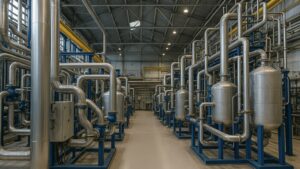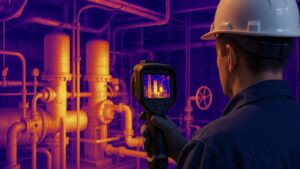The oil and gas industry finds itself at a pivotal juncture. While still supplying over half the world’s energy, its dominance is challenged. It stands to be challenged by climate change policies and competition from renewables. Moreover, shrinking access to low-cost reserves is also a major cause. To navigate this turbulence, the industry must dramatically curtail its environmental impact. A technology proliferating in promise and feasibility is oil and gas electrification. By replacing traditional diesel, gas, or coal-powered equipment with electric systems running on renewables, grid power, or a combination, asset electrification provides a pathway. This is to radically reduce emissions while enhancing efficiency.
Electrifying assets will grow ever more urgent and profitable. This is because nations now rally around ambitious net-zero commitments and investors are shifting capital towards sustainable businesses. From mammoth offshore platforms to remote pumping stations, transitioning infrastructure from molecules to electrons unlocks remarkable potential. Moreover, for communities living nearby, it alleviates local pollution. For operators, it also bolsters performance while harnessing digitization.
Assets integrated with smart power management and storage become more responsive, reliable, and resilient. Additionally, for the planet, it averts huge volumes of carbon emissions. The technology underpinnings, business case, and policy backing for asset electrification continue gaining strength. In this article, we will explore its roles, benefits, and more. So, let’s get started.
Strategic roles of asset electrification
Implementing asset electrification serves multiple crucial roles for oil and gas firms. It navigates the energy transition while delivering financial, operational, and environmental benefits:
Achieving emissions reductions commitments
Replacing onsite fuel combustion with renewable-electrified systems eliminates large volumes of air pollutants and greenhouse gases. This directly tackles emissions from powering drilling rigs, offshore platforms, and other equipment. So, it is critical for achieving net-zero aspirations.
Enabling advanced digitalization
Integrating sensors, and data infrastructure during initial electrification projects lay the foundation. This is for future monitoring, automation, and predictive analytics capabilities. Moreover, the viability of advanced algorithms depends on high-quality data flows.
Overcoming capital limitations
Phasing incremental upgrades from diesel gensets to electric systems through modular components prevents stranding assets. Furthermore, customized right-sizing aligns with infrastructure readiness and operations strategy flexibly.
Maximizing asset performance
Precision electric drives optimize productivity. This is through increased drilling accuracy, enhanced chemical injection control, and precision valve automation. As a result, production levels and equipment effectiveness rise.
Power supply resilience
On-site renewable microgrids and storage-free operations help in getting away from fuel delivery risks. Moreover, solar, wind, and batteries establish self-sufficient energy autonomy. They are also uninterrupted by external disruptions.
Regional decarbonization momentum
Success with initial critical asset electrification motivates adoption across the oil & gas value chain. It also supports economies of scale for renewables, hydrogen, and carbon capture. As a result, it accelerates industry transition.
Harnessing increasingly affordable clean energy
A major impetus for asset electrification is eliminating on-site carbon emissions. Refineries, pipelines, and platforms once solely powered by extracting and burning fossil fuels now integrate solar, wind, hydroelectricity, and storage to varying degrees. Moreover, the plunging prices of renewables have made them cost-competitive with gas turbines and diesel generators in many instances.
Solar photovoltaics, onshore wind, and lithium-ion batteries have declined. This is to approximately 90%, 70%, and 97% respectively in the past decade. New solar or wind-powered plants in the Middle East regularly bid electricity below $20 per MWh. So, it is significantly under new thermal generation.
Given asset lifetimes over 25 years, both pollution and costs can be slashed. It can be done by switching to renewable energy technologies harnessing free irradiation and wind resources. So, deployment scales efficiently from a few megawatts to gigawatt-scale complexes. This is through modular solutions like solar PV panels and wind turbines mass manufactured globally.
Regional oil giants like ADNOC and Saudi Aramco are crafting formidable renewable portfolios. It helps them to meet operational loads. Where full electrification proves challenging presently, technologies like green hydrogen and carbon capture offer interim abatement. However, the overarching shift from molecules to electrons for powering oil and gas infrastructure is gaining momentum globally. Its credit goes to enabling cost and technology trends.
Key benefits of transitioning to electric assets
In addition to meeting sustainability targets, asset electrification also promises direct economic savings and performance gains. This is through increased efficiency, resilience, and reliability:
Substantial operational expenditure savings
Eliminating diesel and gas expenses by switching to efficient electrified systems powered by lower-cost renewables or grids slashes opex by over 50% in many contexts. It also adds up to massive savings.
Improved reliability and uptime
Higher redundancy, condition monitoring, predictive maintenance, and modular components in electrified systems reduce the frequency and duration of shutdowns. It is done through superior diagnostics.
Enhanced responsiveness
Precision torque control with fast response times down to milliseconds enables tuning parameters. This is for complex oil and gas processes dynamically in real-time for optimized output.
Increased production volumes
Higher on-stream time and optimize processes through precision electric valves, pumps, compressors, and other components directly translate to more barrels or boe output.
Future regulations preparedness
Proactively electrifying future-proof assets against tightening emissions policies. It also future-proofs against carbon pricing mechanisms, and bans on diesel/gas equipment over upcoming decades.
Multi-stakeholder goodwill
Tangibly executing emission reductions and environmental stewardship builds community and government political goodwill. It also maintains a social license to operate.
The converging roles and advantages of oil and gas electrification make clear the overarching benefit. That is strategically future-proofing assets. It helps to deliver lower carbon, lower cost, and lower risk operations through technology innovation.
Optimizing production through high-performance electric systems
Beyond environmental gains, the business case for oil and gas electrification keeps improving too. Studies by prominent firms like Goldman Sachs and Rystad Energy project switching from mechanical drives and gas turbines to electric drivetrains will pay off. This is through higher efficiency and lower operating expenses within a few years. Moreover, increased uptime and production levels then multiply savings across an asset’s lifecycle.
Electric rotating equipment often exceeds 90 percent efficiency. This is with precision torque control enhancing drilling accuracy, fluid handling, and chemical injection performance. Maintenance needs also decrease without exhaust filters or lubricating requirements compared to diesel engines. Efficiency advantages will further expand as capacity factors for renewable generation increase while costs continue falling.
Transitioning fully to an integrated electric architecture also optimizes the entire production environment. Standardized components with digitally enabled “plug-and-play” connectivity reduce downtime when swapping modules.
Streamlined power distribution removes redundancies across disparate generation and distribution infrastructure. Furthermore, situational intelligence, predictive analytics and eventual automation enabled by sensors optimize throughput. So, the superior controllability of power electronics over mechanical drives also enables achieving precision control unviable previously.
Attaining energy autonomy
Getting rid of the need for fuel deliveries is a good thing when we compare electric and fuel-powered stuff. It’s tough to transport and store fuel for generators in faraway places, like remote oil fields. This can be a logistical challenge, and it’s risky if we run out of fuel in the storage tanks. But if we use electricity from the sun, wind, or power lines, we don’t have to worry about transporting and storing fuel.
Also, if we use special batteries with renewable energy, we can create our own energy system that won’t easily stop working. These batteries can store extra energy from the sun or wind, so we can use it later when we need it, like during the night or storms. In the future, smart systems can help manage energy better, so things work well even if the energy supply changes. So, by using both electricity and fuel in flexible and reliable systems, we can make off-grid oil and gas operations better.
Overcoming challenges to electrification adoption
For all its advantages, barriers remain in implementing asset electrification at scale. One limitation has been infrastructure constraints both onshore and offshore. It stands to be there because many oil sites weren’t designed with surplus power capacity in mind. Furthermore, interconnecting adjacent platforms also poses complications from a safety and structural standpoint. Clarifying rules and mechanisms for sharing infrastructure also occasionally still faces regulatory disputes given commercial sensitivities.
Upgrading transmission infrastructure is equally crucial to tap affordable renewables. There are also lengthy queues and delays in approving projects that discourage development. In the North Sea, grid interconnection disagreements between countries have hindered trade. These were with the intent to enable better renewable integration. So, regulators must collaborate to accelerate enhancements while clarifying standards for cross-border links.
Additionally, the technology readiness level of electric solutions necessitates further progression. This is across heavy industrial applications like large drilling rigs and offshore platforms. So, continue prioritizing partnerships between innovative developers and supportive operators willing to pilot new technologies. This will mature portfolios until both technical and economic hurdles to mass adoption dissipate.
Capturing the value in asset electrification
The future of oil and gas sector electrifying assets holds remarkable potential. It is powerful in delivering cleaner, efficient production while avoiding business disruptions from inevitable energy transition policies. As pressure mounts to report absolute emission reductions, electric architectures provide a viable path forward. While barriers exist, improved economics, maturing technology and supportive policy are overcoming obstacles. Companies are also proactively embracing appropriate electrification opportunities. They will gain a competitive advantage by future-proofing investments and operations.
From accessing stranded reserves to developing massive new complexes, electrons promise to unlock substantial new value across oil and gas portfolios. This is while aligning with net zero aspirations. It stands to be the future of oil and gas sector.
The surest path to commercial progression involves nurturing collaboration between operators, technology disruptors, and the public sector. By pooling intellectual and financial capital, electrification’s momentum will accelerate – elevating it from discrete testing to an indispensable pillar of next-generation production environments.
Conclusion
Asset electrification in the oil and gas industry is becoming more popular for several reasons. The benefits are increasing, and the obstacles are decreasing. The costs are going down, and there’s proof that it works. There’s also a sense of urgency to meet environmental and social goals. People are no longer asking if this change will happen but when.
Technology is making it easier for this shift to electricity, thanks to collaboration between different groups. Smart leaders are creating plans to use electricity in their operations to make sure they stay competitive and efficient. Being one of the first to make this change can give a company a big advantage.If you want to be among the first ones to capture this unmatched potential, attending the Global Summit on Net Zero Energy Production is the right opportunity. The event will take place in Amsterdam, Netherlands on 30-31 January 2024. Over 30 industry leaders will be gracing the event with over 100 attendees. It will have multiple networking sessions and will cover all the essential topics needed for companies. This is to become an efficient company with net zero emissions following all guidelines. Some of the topics include asset electrification, reducing on-site emissions, low-carbon hydrogen production, and more. So, make sure you don’t miss the opportunity!





